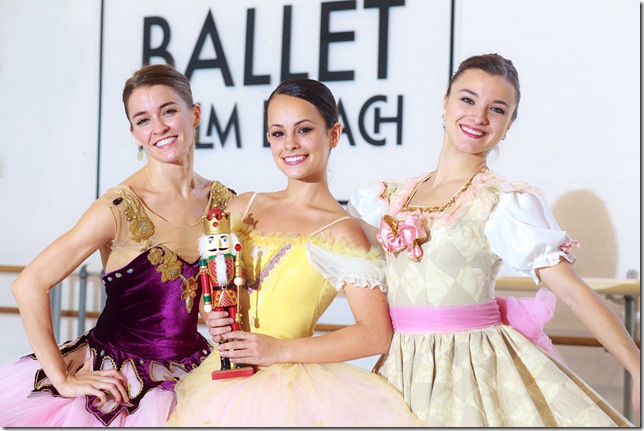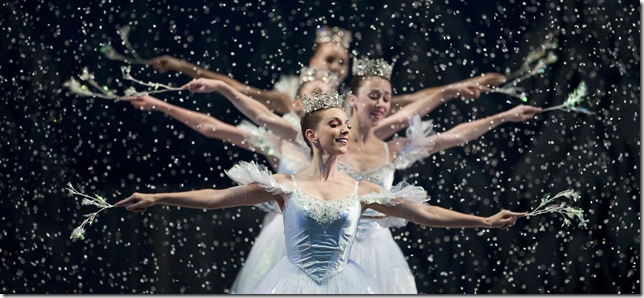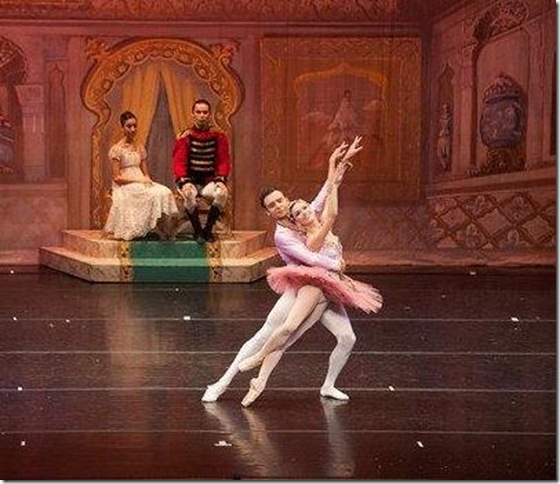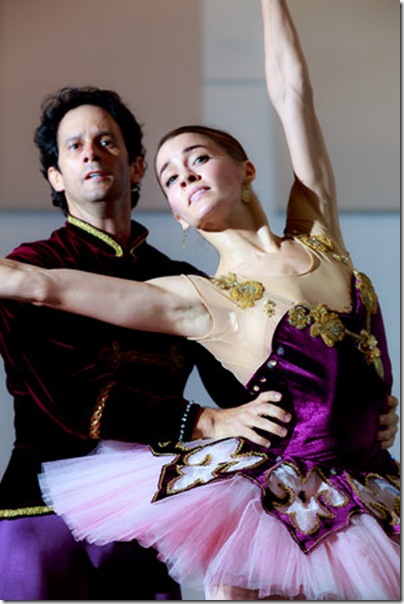All over the country at this time of year, in prop rooms big and small, someone is dusting off the head of the Mouse King.
It’s time, in other words, for The Nutcracker, a ballet from Imperial Russia that has been an indelible staple of American culture for decades, an unmistakable sign of the holiday season as familiar as Ebenezer Scrooge and round-the-clock Christmas carols.
“The thing that makes ‘Nutracker’ really special is No. 1, the score, that’s the leading point,” said Dan Guin, executive director of Boca Ballet Theatre. “The second thing is that every little girl wants to dream. And this is about a little girl’s dream … Every little girl wants to be the princess and have her dream come true.
“And it’s holiday, and family. How warm can it be?”
Educational dance troupes and ballet companies across the nation routinely include The Nutcracker in their performance seasons, and can count on this singular story and Piotr Ilyich Tchaikovsky’s beloved music to be a family-friendly lure for people who otherwise would never darken the door of a dance show.
The Nutcracker can be seen in South Florida in at least five different productions this season, and two of them begin Friday, the day after Thanksgiving. The Boca Ballet Theatre’s production can be seen four times at its stage home at Olympic Heights High School, and Ballet Palm Beach presents its version four times at the Eissey Campus Theatre on the campus of Palm Beach State College in Palm Beach Gardens.
Colleen Smith, artistic director of Ballet Palm Beach (which until last year was known as Florida Classical Ballet Theatre), said sometimes it can be difficult to work up enthusiasm for yet another performance of The Nutcracker.
“The professional dancers that are here have been performing it for centuries; it’s the thing they perform the most,” she said. “However, the music is so gorgeous you can kind of get past it a bit. And you’re not always using the same people in the same roles.”
And the troupe’s students are always “so joyful about it,” she said. “Suddenly, the march from Act I comes on, and they’re ecstatic to hear it. They’re beyond themselves, they’re so happy.”
After all, there’s something to be said for tradition.
“Of course, I would like to change up our ‘Nutcracker,’ but you can’t change up turkey and stuffing too much,” she said. “People are coming with an expectation of tradition. They want tradition. We have traditions in our families, we have traditions in our cultures, we have tradition in religion. It’s very important to how society works, and this is our part of that.”
The Harid Conservatory in Boca Raton also will present Act II of The Nutcracker, which begins with Clara’s journey to the Land of Sweets and contains the most familiar music in the show, from the Arabian Dance to the Dance of the Sugar Plum Fairy to the Waltz of the Flowers. Other works are included in the Harid’s winter show, which has two performances on Dec. 13 and 14 at the Countess de Hoernle Theatre in Boca Raton.
Further south, Vladimir Issaev’s Arts Ballet Theatre of Florida, based in North Miami Beach, presents The Nutcracker on Dec. 7 at the Fillmore Miami Beach, Dec. 12-14 at the Aventura Arts and Cultural Center in Aventura, and on Dec. 20 and 21 at the Parker Playhouse in Fort Lauderdale.
And area residents with long memories will recall Ballet Florida’s beautiful annual production of The Nutcracker at the Kravis Center, which routinely drew large holiday crowds. With that company’s closing in 2009, that niche has been filled by Miami City Ballet, which presents the George Balanchine staging of the ballet a grand total of 22 times in Miami-Dade, Broward and Palm Beach counties.
MCB will present The Nutcracker five times at the Broward Center or the Performing Arts in Fort Lauderdale from Dec. 12-14, 10 times at the Ziff Ballet Opera House in Miami from Dec. 18-24, and seven times at the Kravis Center, from Dec. 27-30.
Balanchine, indeed, is the chief progenitor of The Nutcracker as an American holiday tradition. Beginning with his 1954 smash-hit production of the work for New York City Ballet, Balanchine cannily summoned up the Russia of his youth — where he saw revivals of the original 1892 production — and presented it in sweetly nostalgic terms that fit beautifully with the emergent suburban domesticity of the Eisenhower era, according to Apollo’s Angels, Jennifer Homans’s excellent 2010 history of ballet.
“Balanchine was a genius and a master of design … and he did come up with the way you do ‘The Nutcracker,’ with the growing tree and the big skirt for Mother Ginger and all of those things,” Guin said. “He was smart enough to see the marketing potential in it. He was like, ‘Oh, this could be like ‘A Christmas Carol’ or ‘Messiah,’ this is the ballet holiday thing’ … Something like 50 percent of all ballet tickets sold for the entire United States are sold to that one ballet every year.
“So in that way, it’s an amazing thing. For me, and our mission of combining professionals with young people, I designed this production to be a stepping stone,” he said. “Each piece of choreography, each section of it, was designed specifically (for students) to interact with professionals on a certain level as they grew as dancers, since it is the one story that’s about a child that you can include children in without destroying the integrity of the ballet.”
Both local productions get underway around Labor Day, with Boca Ballet Theatre auditioning dancers the week before, and Ballet Palm Beach the week after.
Boca Ballet Theatre’s cast includes 121 people, two of them guest artists from the American Ballet Theatre, Devon Teuscher (Sugar Plum Fairy) and Alexandre Hammoudi (Cavalier). Ballet Palm Beach will field more than 80 people for its production, with company professionals Lily Ojea and Rogelio Corrales as the Sugar Plum Fairy and the Cavalier.
Both local companies have produced The Nutcracker for years – 23 in the case of Boca Ballet Theatre, 18 for Ballet Palm Beach. Guin forthrightly says he’s proud of his staging of the ballet, which he says pays particular attention to production values; for example, since the fight between the Nutcracker and the Mouse King has always looked Napoleonic, Guin makes sure that the rest of the costumes are in the first decade of the 19th century rather than the Victorian era.
“What I like about my version is my version is very clean, with timelines and costumes and sets; it’s cohesive, a classic production. There’s no real weird things here, like Clara’s not making out with Drosselmeyer and I’m not dealing with the Starfish Fairy,” he said. “People have asked me, ‘Why don’t you do a Boca version that’s pink and teal?’ and I say, ‘Because that’s not what I’m here to do. I’m here to teach people the standards and the classics.’”
The story of The Nutcracker, drawn from a fairy tale by the early Romantic writer E.T.A. Hoffmann (whose work also inspired Offenbach’s opera The Tales of Hoffmann), is odd when looked at dispassionately, and quite unlike most ballets in that it a series of character dances in which a prima ballerina plays only a small, if very distinctive, part.
“Ideally, if I had enough professional dancers, all the characters that came to the party in Act I would become all the characters that show up in Act II. That would be wonderful and perfect,” said Smith, whose Nutcracker vermin are rats rather than mice. “But in our ‘Nutcracker,’ the Sugar Plum Fairy and the Cavalier are her parents … there are similarities in the formations of the little boys in Act I to what the rats do in the second scene. The audience, even if they haven’t put it together, it draws continuity from one part to the next part.”
For both of these companies, the educational mission is primary, and critical. It’s likely that The Nutcracker is the work that introduces most children to the ballet in the first place, and Guin and Smith both proudly told stories of former students who have gone on to careers in dance, or whose dance experience has helped broaden their lives.
“My youngest students, their assignment is to write me a back story on their character, and they turn it in so I can see, and then they try to play that out on stage,” Smith said. “It’s a wonderful learning tool for them, because as they get older and get cast in some of the other ballets, they need the same thing.”
Guin said he also doesn’t like to see untrained children on stage. 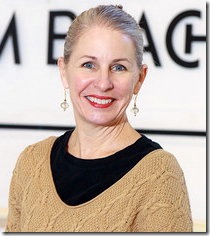
“Obviously, an 8-year-old isn’t going to have the artistic aplomb of someone that’s 18 and going to be a professional might have, or professionals that have had years of experience. So I very much tried to do a production in which each step was going to be appropriate for the growth of a young dancer and how they interacted with professionals,” he said.
For the companies as much as their audiences, The Nutcracker is a family tradition. Guin has hosted 15 to 20 people, most of them guest dancers in the show, at his house for Thanksgiving for 23 years, and Smith holds a post-show pajama party for the children in which a dinner is followed by a video of the show so they can see their performances.
It comes down to the importance of this art form as a tool for growth and a source of inspiration.
“For any child, it focuses them. It’s so beautiful for the body, and it just educates them on so many levels that have nothing to do with being a professional dancer: Time management, discipline, self-control, an appreciation for music and art,” Smith said.
And when it comes to The Nutcracker, it’s about what Guin calls “the magic” of this unique show. He says one of his annual pleasures in staging the ballet is seeing the younger members of his audience after the performance ends.
“I don’t know if you’ve done that, just sat in the parking lot after a ‘Nutcracker,’ just sat in the parking lot and watched the kids,” he said. “I love it. You see little kids just dancing in the parking lot, and that’s what it’s all about. It’s a kids’ fantasy.”
BOCA BALLET THEATRE presents The Nutcracker at 7 p.m. Friday, 2 p.m. and 8 p.m. Saturday, and 2 p.m. Sunday at the Olympic Heights Performing Arts Theater on the campus of Olympic Heights High School in Boca Raton. Tickets are $20-$35 for adults, $10-$25 for children and seniors. Call 561-995-0709 or visit www.bocaballet.org.
BALLET PALM BEACH presents The Nutcracker at 7:30 p.m. Friday, 2 p.m. and 7:30 p.m. Saturday, and 2 p.m. Sunday at the Eissey Campus Theatre on the campus of Palm Beach State College in Palm Beach Gardens. Tickets start at $15. Call 561-207-5900 or visit www.balletpalmbeach.org.
